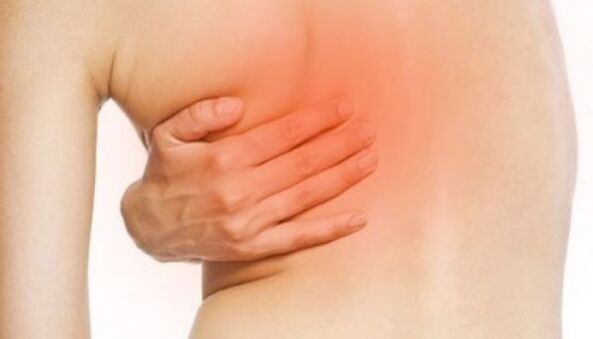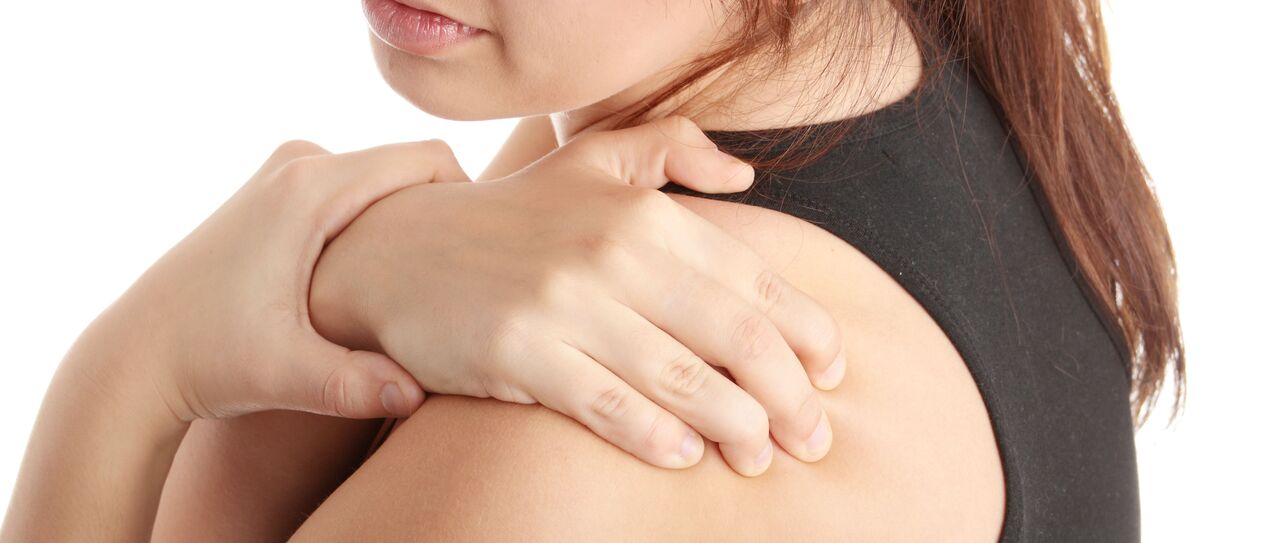Painful sensations under the shoulder blade - this symptom can be encountered by adults suffering from diseases of the musculoskeletal system or pathology of the internal organs, and children who simply did not calculate physical activity or were up to date.
The use of painkillers alone in the event of subscapular pain is absolutely unacceptable: such sensations of pain can be a sign of life-threatening conditions.
At the same time, attention and often emergency medical care deserve not only acute pain, but also dull pain under the left shoulder blade.
The nature of the pain and the accompanying symptoms help to suggest a specific disease. However, only a qualified doctor, based on the patient's complaints, will be able to understand which organ damage caused the pain, prescribe the necessary diagnostic examination and, if necessary, provide emergency care.
Causes of pain under the left shoulder blade in the back of the back

The proximity of the lungs, heart and spine, as well as the extensive network of nerve fibers, expands the list of possible causes of subscapular pain. In this case, each disease is characterized by other specific signs, and the nature and duration of pain also change.
Pathology of the musculoskeletal system and nerves
Diseases of the spine and muscular frame of the back are common causes of subscapular pain on the left. The pain in such diseases is often unilateral.
- Osteochondrosis - the formation of osteophytes in the thoracic or cervical spine provokes pulling pain on the left or right, starting from the neck and upper back and ending with radiation in the arm. The pain does not disappear at rest, it is often prolonged but bearable.
- Intercostal neuralgia - accompanied by intense pain that spreads throughout the intercostal space and is exacerbated by breathing, turning, sneezing / coughing. Neuralgia often changes the sensitivity of the skin to the source of pain. Neuralgia provokes paresthesia in the form of goosebumps, while numb pain under the left shoulder blade often occurs in myocardial infarction, angina pectoris.
- Shovel syndrome - is a "reward" for hard physical work or activities associated with a long stay in one position (office workers). People complain of mild dull pain, located between the neck and shoulder, radiating under the shoulder blade.
Important! The causes of pain under the left shoulder blade from the back of the back, which radiates into the arm and is of a pressing nature - osteochondrosis and angina pectoris - have a distinctive feature. In angina pectoris the pain lasts up to 30 minutes, in osteochondrosis - several days. In addition, an attack of angina pectoris is stopped with nitroglycerin or other heart medications.
Sometimes pain under the shoulder blade is provoked by myositis (at the same time there is stiffness of movements and tension of certain muscle groups), injuries to the shoulder blade (acute pain, always preceded by a fall, blow, etc. ) or oncology (pain may occur)periodically, not intensively). Bone tuberculosis, namely scapular lesions, cannot be ruled out.
Diseases of the heart and blood vessels
Cardiac pathology is one of the most dangerous, which can be diagnosed when the patient complains of pain under the shoulder blade. In this case, the pain in heart disease does not always start from the front surface of the chest (behind or to the left of it). The cause of pain under the left shoulder blade in the heart area may be:
- Angina pectoris - the pressing pain behind the sternum extends below the left shoulder blade and clavicle, in the jaw and arm. The intensity of the pain decreases at rest, but the change in body position does not bring relief. In scapular-costal (vertebrogenic) syndrome, the situation with increased pain is radically opposite. The attack of angina pectoris is equalized with the intake of nitroglycerin, with back pain, manual therapy is excellent.
- Myocardial infarction is an acute, increasing pain in the heart with characteristic irradiation to the left (including below the shoulder blade), which is not stopped by cardiac glycosides. The patient experiences severe fear, which is not the case with damage to the spine and nerve fibers. Immediate hospitalization is required!
- Hypertensive crisis - often accompanied by depressing heart pain radiating to the left shoulder blade. The cause of pain is easily determined by measuring a / d.
- Pericarditis - in this disease the pain subsides at rest and when the trunk is tilted forward. The pain occurs in the area of the heart in front, radiates under the shoulder blade, but not as intense as in acute myocardial ischemia (angina, heart attack).
- Detachment, aortic aneurysm is a dangerous condition characterized by throbbing pain under the scapula. The rapid increase in pain requires an urgent call to the medical team.
Important! Both ischemic heart disease (angina pectoris, heart attack) and cervical osteochondrosis are characterized by numbness of the tongue on the left.
Important! Often a symptomatic picture, similar to cardiac pathology, gives vegetative-vascular dystonia. At the same time, the demonstration of his serious condition is clearly pretended (psychogenic factor), the patient is often nervous, trembling, experiencing fever and a feeling of a lump in the throat.
Respiratory diseases
Pain under the left shoulder blade can cause the following lung diseases:
- Pneumonia - gives pain only when the source of inflammation is located near the pleural membrane. Painful sensations of low intensity occur periodically, have a point localization and intensify when breathing.
- Pleurisy - unlike pneumonia, the pain is sharp, piercing. Its intensity depends on the depth of breathing.
Accompanying pulmonary symptoms accompanying pain when inhaling under the left shoulder blade are shallow, rapid breathing, shortness of breath, fever. Hyperthermia can also occur with pericarditis. Extremely rarely, a slight increase in temperature is observed in severe neuralgia, myositis.
Important! Unlike heart disease, in pathology of the respiratory tract the pain is accompanied by night sweats and cough (in the initial stage of pneumonia and in pleurisy - dry).
Pathology of the gastrointestinal tract
Pain under the shoulder blade often accompanies gastrointestinal diseases. In this case, the symptomatic picture is as follows:
- Peptic ulcer - severe cutting pain is always associated with food intake (occurs before or immediately after eating), radiates to the scapula with nonspecific localization of the ulcerative process (posterior wall of the stomach or its heart). The pain subsides after vomiting, taking acid-lowering drugs. The perforation of the ulcer is accompanied by increased pain (such as cutting with a knife), the patient presses his legs to the stomach and covers them with his hands.
- Pancreatitis - accompanied by severe lumbar pain (including under the left shoulder blade). The attack is always associated with eating errors (fatty, salty, fried foods, alcohol, starvation). Vomiting does not bring relief.
Important! The pathology of the gastrointestinal tract, which caused pain under the shoulder blade on the left side, is accompanied by other characteristic symptoms - bloating, indigestion, vomiting, belching.
Diagnosis of subscapular pain
When collecting the anamnesis, the doctor pays attention to the connection of pain with physical activity, food intake, stress, and also specifies concomitant chronic and recent diseases.
Assessing the nature of pain, the presence of certain symptoms specific to diseases of various organs, allows you to narrow the range of causes to a specific body system - heart, lungs, musculoskeletal system, gastrointestinal tract. The preliminary diagnosis is confirmed by the following tests:
- heart - measurement of a / d, ECG, echocardiography and Doppler scanning;
- lungs - chest X-ray;
- spine - X-ray of the neck and chest, CT or MRI.
In the future, a more detailed examination of the damaged organ may be necessary. Only then is the treatment of the established disease prescribed.
When and to which doctor should I go?

Depending on the degree of intensity and the nature of the painful sensations under the shoulder blade, the accompanying symptoms, you should consult a doctor:
- emergency call for emergency - sudden onset of pain of increasing intensity and rapid deterioration of the general condition;
- traumatologist - getting an injury that provokes pain;
- cardiologist - with concomitant chest pain (permanent or recurrent), shortness of breath, cyanosis;
- neurologist, orthopedist - pain under the left shoulder blade, aggravated by raising the arm, there is a clear link between the onset of pain and physical activity, previously diagnosed degenerative pathology of the spine;
- gastroenterologist - there is a connection between pain and food intake, there are other signs of gastrointestinal disease (nausea, vomiting, etc. );
- pulmonologist - pain under the shoulder blade is accompanied by cough, shortness of breath;
- therapist - the pain occurs for no apparent reason, permanent or temporary.
The therapist often diagnoses both trivial VSD and finds evidence of acute surgical pathology or cancer. In the future, the doctor will appoint a consultation with a specialist of a narrow profile.
Preliminary treatment regimens
Depending on the diagnosis, the attending physician chooses effective treatment for the cause of the disease. An important point in the complex therapy is the elimination of the pain syndrome:
- In neurological pain, strong painkillers are most often used;
- The pathology of the spine and muscles requires a course of nonsteroidal anti-inflammatory drugs;
- Heart disease - pain syndrome requires nitroglycerin (does not help with heart attack), Validol has only a reflex effect and in no way improves the condition of the heart muscle in ischemic disease;
- If you suspect gastrointestinal disease, it is recommended to take antispasmodics, acid-lowering drugs (with ulcers).
Only by eliminating the cause of the disease, the patient gets rid of the pain under the shoulder blade. Acute conditions sometimes require urgent hospitalization and intensive care.
The radicality of treatment depends on the nature of the disease and the duration of its course, so you should consult a doctor at the first painful symptoms. Not only the outcome of the disease depends on this, but also the chances of full recovery increase.
In severe cases, timely medical care saves the patient's life.























